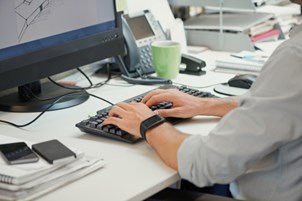
It’s no secret that sitting down too much is bad for your physique, but did you know it’s also bad for your health? Cardiologists have claimed that those who sit for the majority of the day have the same risk of heart attack as smokers. Health, fitness and ergonomic design seem to be recurring office buzzwords, but are people and workplaces really taking note?
Global studies have shown that, on average, we sit for 7.7 hours a day – with some people estimated to sit up to 15 hours a day. Think about it; we’ll get up in the morning and potter around the house, but then the second we leave the front door, most of us will begin the addictive cycle of sitting. If we drive or take public transport, we’ll be sitting during our commute. If we work in an office or desk job, we’ll be sitting staring at our screens. Then we’ll commute home and sit down at dinner, relax on the couch and maybe stare at some more screens, then head to bed.
The cycle repeats; and surprisingly, regular exercise won’t do much to combat the detriments of sitting if the time spent sitting outweighs that of standing or exercising. It seems quite grim, but sitting for extended periods of time is linked to obesity, metabolic syndrome, increased blood pressure, high blood sugar, type 2 diabetes, excess body fat around the waist, abnormal cholesterol levels and increased risk of death from cardiovascular disease and cancer.
Sitting all day can also reduce the clarity of your thinking. Low muscle movement means less fresh blood and oxygen pumped to the brain, thus stifling the release of mood enhancing chemicals. Without stimulating muscle movement, your brain will in turn be less energised and more lethargic. It’s actually not advantageous for you to just be sitting down at your desk all day at work!
Although there’s a range of diseases and infirmities associated with sitting, it’s not all bad news: just 1 minute of standing each hour can be beneficial. Research has shown that taking these ‘mini breaks’ every hour can reduce the detrimental effects of prolonged sitting. Here are our three top tips for combatting the adverse effects of excess sedentary time in the workplace and implementing regular movement into your office job.
1. Take a brisk stroll around the office every hour
Can’t get yourself a standing desk? Set a timer on your phone or computer to buzz every 30-60 minutes during the work day. If you wear a fitness band, see if you can activate silent reminders to move. Each time the alarm goes off, you have several options to move and shake:
- Stand for one minute
- Walk to the tap and refill your drink bottle
- Use the bathroom
- Walk to a colleague’s desk instead of emailing them
- Do some standing stretches at your desk.
2. Try to exercise once a day
Any activity is good activity, but 30 minutes of rigorous exercise is the best kind! It might be hard to squeeze in that extra half hour of exercise each day, but the benefits are undeniable. Our tip is to swap that toasty bed for an early 30-minute jog. That magical half hour will reduce your sluggishness and sufficiently energise you for the day ahead.
Here’s how exercise can improve your health and wellbeing:
- Prevents weight gain. Try taking the stairs instead of the elevator, park a little further from work, or walk to/from the train station.
- Helps alleviate high blood pressure and in turn, decreases your risk of health conditions and diseases such as cardiovascular disease, stroke and type 2 diabetes.
- Not only will exercise reduce the risks of health conditions and diseases, it’ll substantially improve your mood over time. The rise in brain chemicals from exercise leaves you happier, relaxed and more confident over time.
3. Stretch
Not only does it improve your flexibility and get blood flowing to your muscles, a study has found that stretching can improve your posture, confidence and overall feeling of self-worth.
- Neck stretch: Sit up straight with your hands holding the sides of your chair; pull your hand on the chair while tilting your neck right; hold for 15-30 seconds and repeat on the other side. Complete repetition 3 times.
- Upper arm tug: Sitting straight, bend one arm behind your head with elbow pointed to the ceiling; place other hand on elbow to stabilise; hold for 15-30 seconds and repeat for other arm. Complete repetition 3 times.
- Hip stretch: sit and place left ankle over right knee; lean forward slightly while keeping back straight until you sense a pull in the right glute and hip; hold for 15-30 seconds and repeat for other leg. Complete repetition 3 times.
- Thigh pull: Stand up and hold the edge of your desk with right hand; grab your left ankle with left hand and pull it backwards, making sure your back is straight; hold for 15-30 seconds; repeat with other leg and complete repetition 3 times.
- Leg reach: While sitting on your chair, raise both legs horizontally with your feet pointing upwards and try to reach your toes with your fingers, with your arms reaching forwards; hold for 15-30 seconds. Complete repetition 3 times.
The more we consider these activities as part of our routines – rather than a decision we need to make – the more likely we are to just go about doing them. By altering our behavior and daily routines just a tiny smidge, we can make long-term improvements to our bodies and ultimately, our health and longevity.



